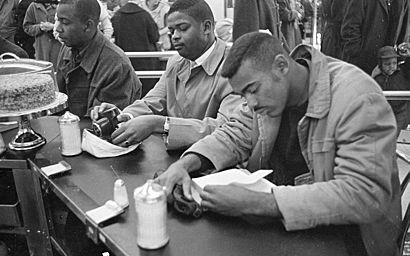Sit-in movement facts for kids
Quick facts for kids Sit-in movement |
|||
|---|---|---|---|
| Part of the Civil Rights Movement | |||

Student sit-in at Woolworth in Durham, North Carolina on February 10, 1960
|
|||
| Date | February 1, 1960 – 1964 | ||
| Location | |||
| Caused by |
|
||
| Parties to the civil conflict | |||
|
|||
The sit-in movement was a major part of the Civil Rights Movement in the United States. It was a time when brave students, mostly African American, sat down in places where Black people were not allowed to be served. They did this to protest against segregation, which was the unfair separation of people based on their race.
These protests were called "sit-ins" because people would sit at lunch counters, restaurants, or other public places that only served white customers. They would stay there peacefully, even if they were refused service or treated badly. This was a type of nonviolent direct action. It meant they protested without using violence. They hoped to show how unfair segregation was and encourage change.
The Start of the Movement
The sit-in movement really took off on February 1, 1960. Four African American college students started a sit-in at a Woolworth's lunch counter in Greensboro, North Carolina. They were Ezell Blair Jr., David Richmond, Joseph McNeil, and Franklin McCain. They became known as the "Greensboro Four."
These students were from North Carolina Agricultural and Technical State University. They simply sat at the counter, where only white people were allowed to eat. They asked to be served, but they were refused. They stayed there until the store closed.
How Sit-ins Spread Quickly
News of the Greensboro sit-in spread very fast. Students at other historically Black colleges and universities were inspired. They started their own sit-ins in cities all over the country. Within weeks, sit-ins were happening in many states. These included Virginia, South Carolina, Tennessee, and Florida.
Many students across the country followed this example. Sit-ins became a powerful way for students to get attention. For instance, in Baltimore, Maryland, students had been protesting against segregated lunch counters since 1953. When they saw how much attention the 1960 Greensboro sit-ins received, they continued their own campaigns.
There was a lot of support from the community for the students' efforts. More and more white people also started to support the idea of ending segregation in public places. The sit-in movement showed how powerful peaceful protest could be. It helped bring about big changes in the fight for civil rights.
Images for kids
-
Student sit-in at Woolworth in Durham, North Carolina on February 10, 1960


